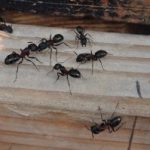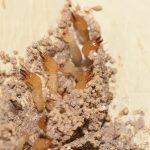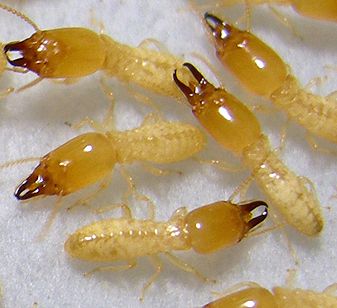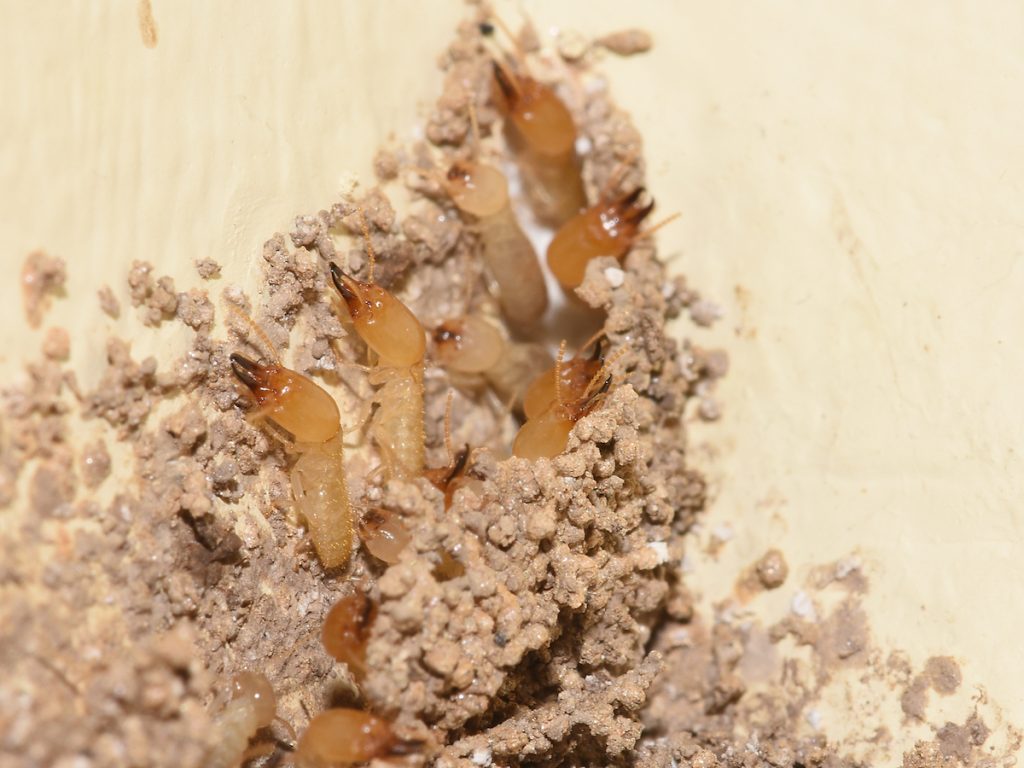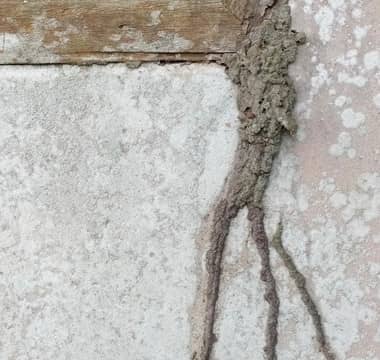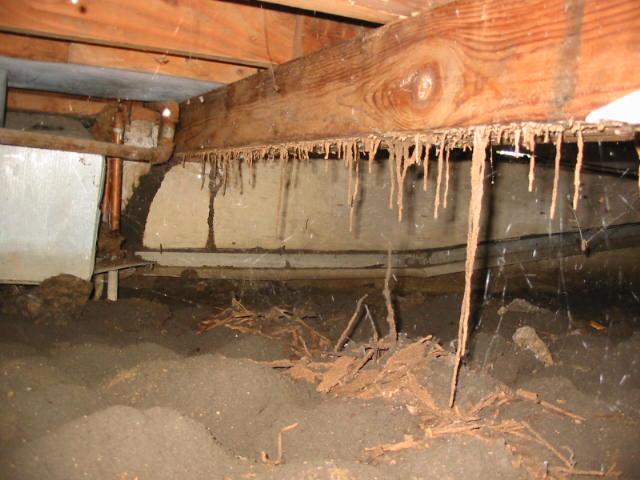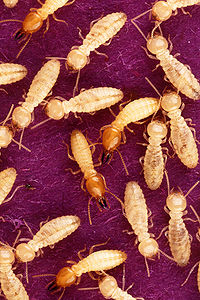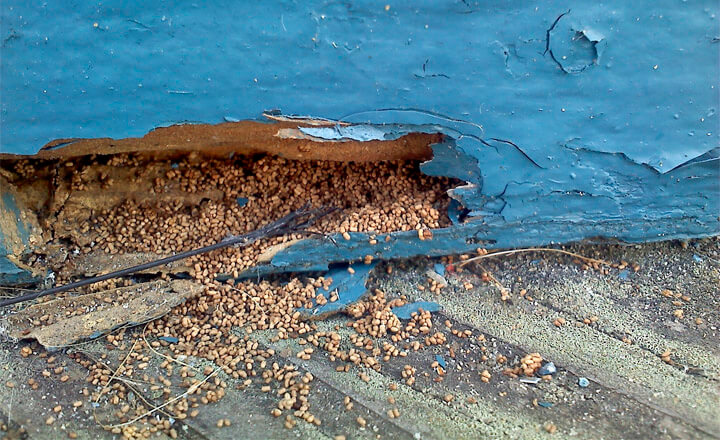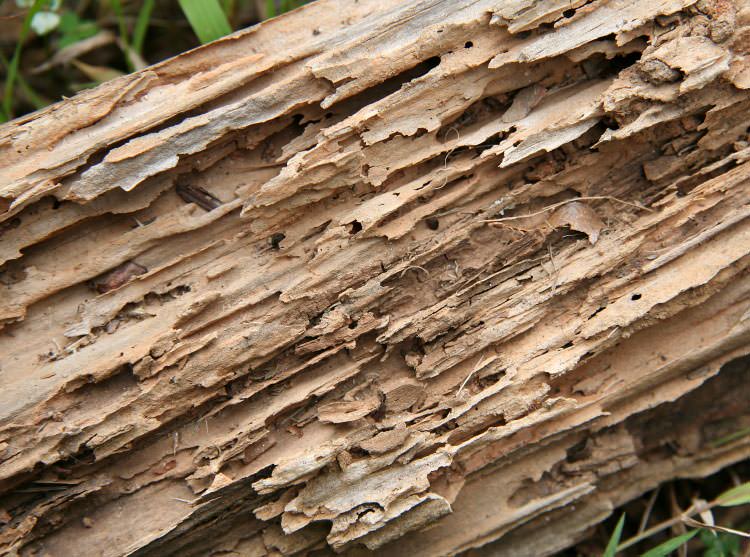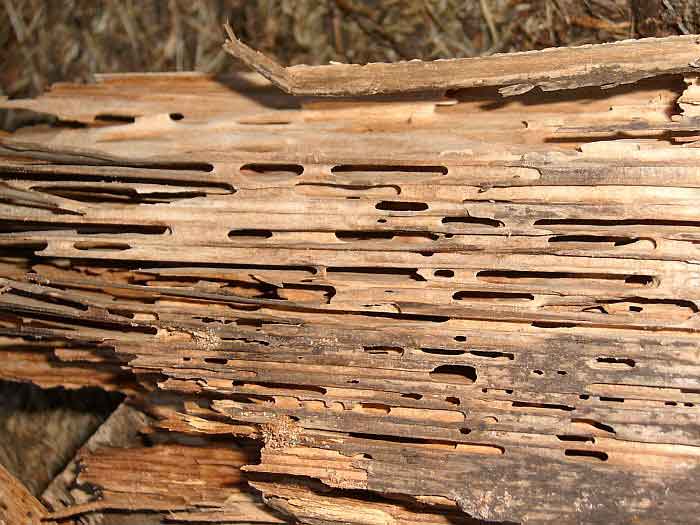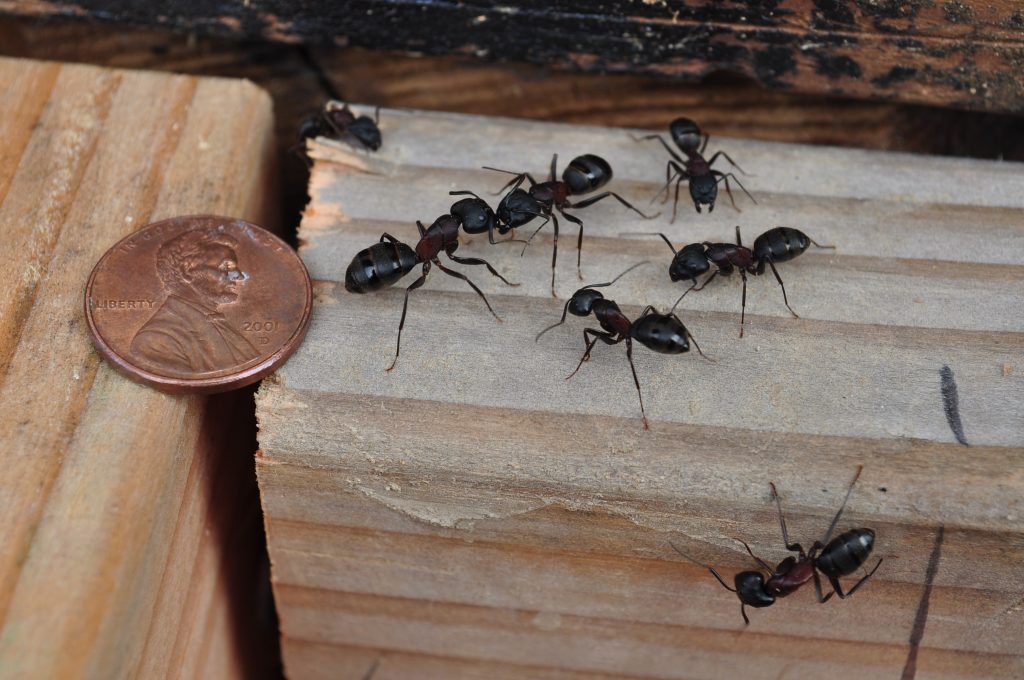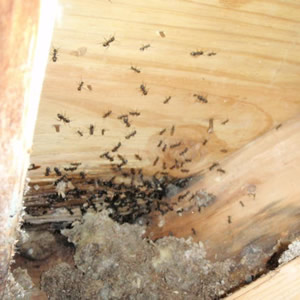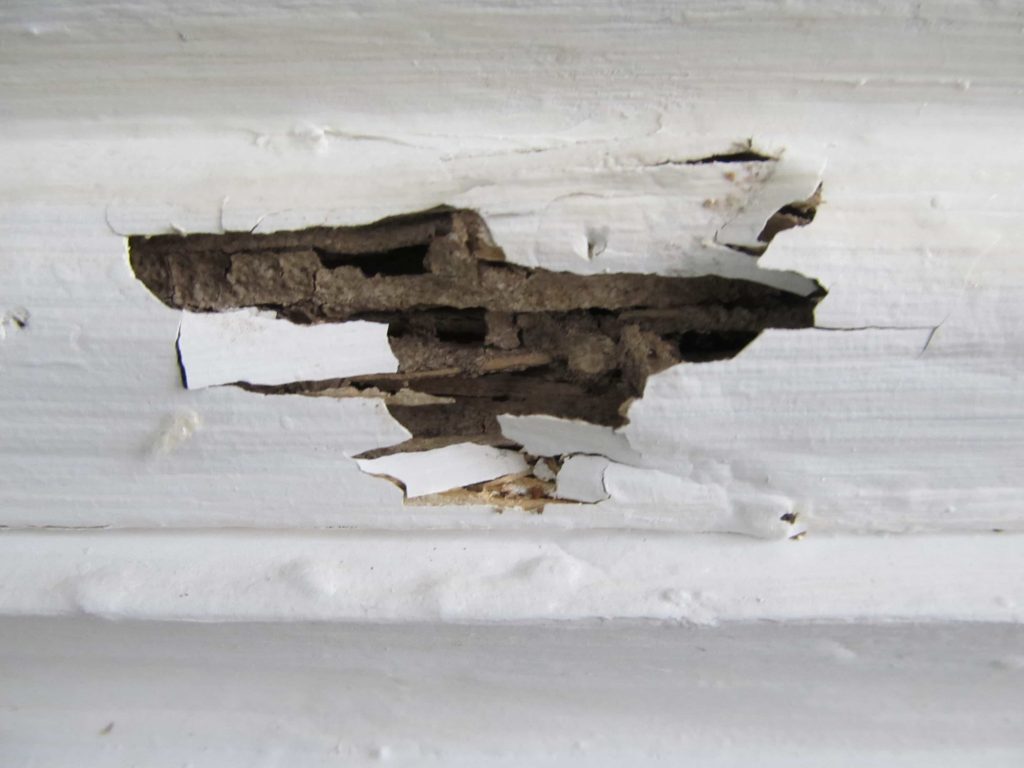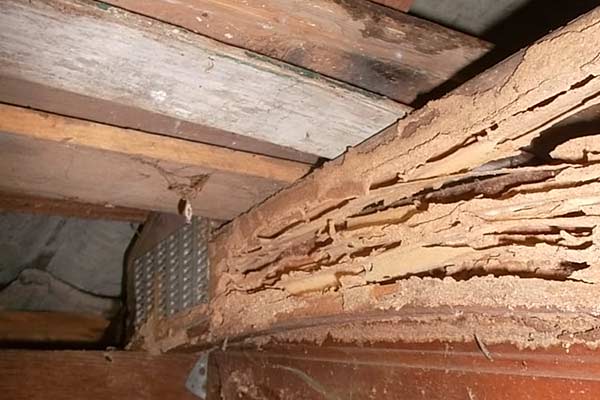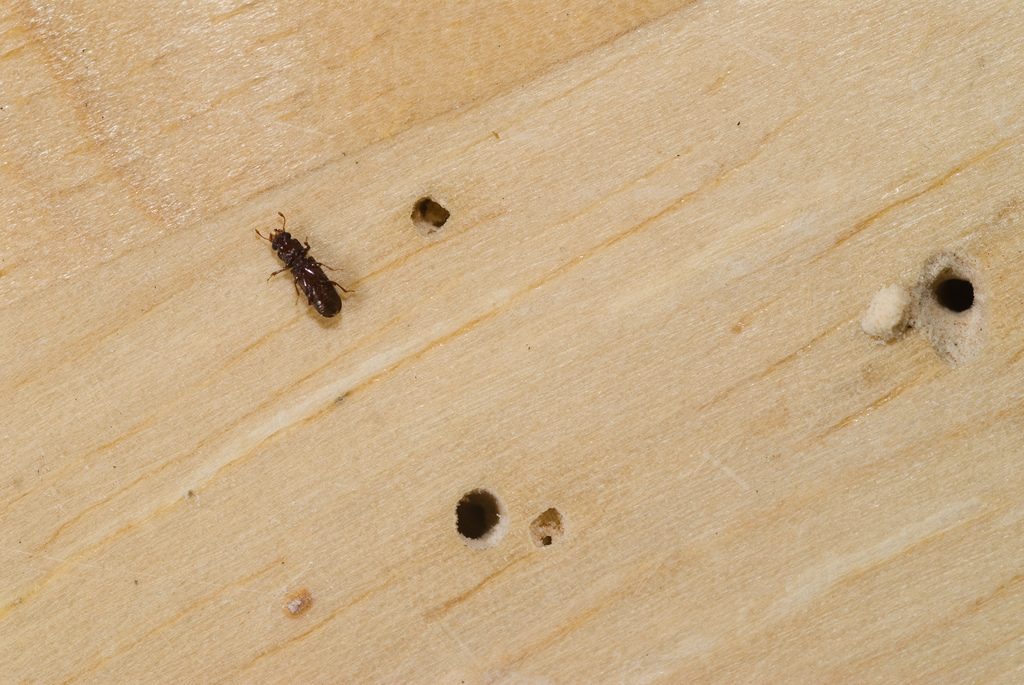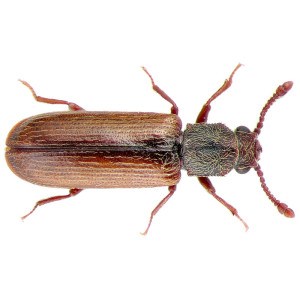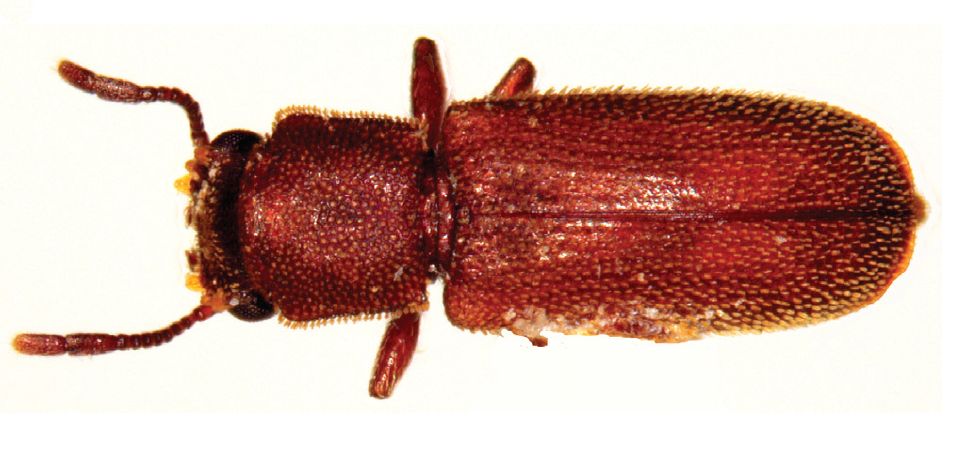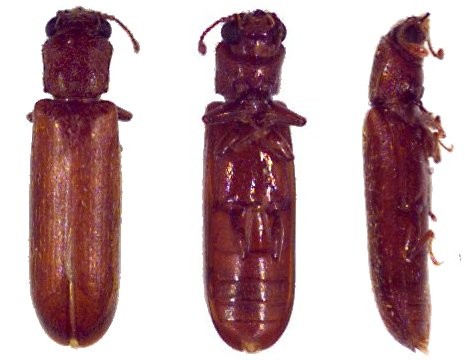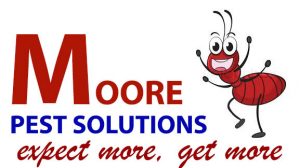
Contact Us Today For FAST Service
360-205-3645
Wood Destroying Pest Control & Prevention
How do you tell the difference between Carpenter Ants and Termites……
Carpenter ants (Camponotus spp.) and termite (Isoptera) are notorious for causing damage to wood in your home. Termites are roughly the same size as the many, many species of large ants that fall into the carpenter ant Camponotus group; and like carpenter ants, termites burrow into wet, rotting wood, making them the enemy of your home’s framing.
Because both carpenter ants and termites swarm in the springtime to mate, they are often confused for one another by homeowners spotting the swarms. A closer look will reveal significant differences.
Identifying Termites
- A termite has no “waist”–instead, its body is more rectangular, without any narrowing in the center.
- The termite has straight, beaded antennae.
- The termite has four wings that are of equal size and shape. Its wings are also longer than its body.
Identifying Carpenter Ants
- The carpenter ant has a very well-defined narrow, constricted waist.
- The antennae of ants are bent or “elbowed.”
- A carpenter ant has four wings, with the back, hind wings shorter than its front fore wings.


Behavioral Differences
Other differences between the termite and the carpenter ant include:
- Color: Ant workers are reddish or dark-colored and are frequently seen in the open foraging for food. Termite workers, by comparison, are transparent, light or creamy white in color, and they avoid light. Termites are rarely noticed unless their nest is disturbed.
- Wing durability: Although reproductives of both types of insects are winged, the wings of the termite fall off easily. The loose wings can often be seen near the opening to the termite nesting site and can be used to identify a termite infestation.
- Use of wood: Termites eat the wood in which they nest. Carpenter ants merely dig into the wood to excavate their nests; they do not eat the wood but simply push it out through openings of the galleries of their colonies. Seeing small piles of wood shavings or frass (insect waste) below the holes helps to identify an infestation of carpenter ants. Carpenter ants seek out moist and damaged wood in which to excavate their nests; termites will chew right into sound wood.
- Tunnel characteristics: The tunnels and galleries of the carpenter ants will be very smooth and finished; termite galleries, by comparison, are rough and ragged because they are filled with layers of soil and mud.
- Mud tubes: A mud tube indicates the definite presence or previous presence of termites. These are tubes built on the outside of walls or between the soil and wood and serve as the passageways through which the termites travel.
Controlling Carpenter Ants and Termites
For both insects, control will include a multi-prong approach using different chemicals to kill existing insects and to repel further infestation. Also of critical importance, you will need to remove and replace structural wood that has been damaged by the insects. A home’s structure can be badly compromised by these wood destroying pests over time.
Top 4 Wood Destroying Pests in the Pacific Northwest
Termites
Termites cost U.S. property owners over $5 billion dollars each year. The average cost to repair termite damage is $3,300.
There are many species of termite that live here in America, but there are really only two types you need to worry about, Dampwood termites and subterranean termites. Knowing the differences between the two can help you know which treatments will be effective at eliminating them from your home or business.
One of the main differences between the two is that dampwood termites do not make mud tunnels while subterranean termites do. Other facts about these two major species are as follows:
Subterranean Termites:
- Live in the soil in large colonies numbering in the hundreds of thousands
- Form mud tunnels to enter buildings to access food sources.
- Infestation usually not seen until damage is severe.
- Cannot eradicate on your own.

Dampwood Termites:
- Invest structures where high moisture levels exist.
- Regular contact with water to survive.
- Do not create mud tunnels, live directly in wood they are eating.
- Can only be seen if you break open the wood they are hidden inside.
- Infestation usually not seen until damage is severe.

There are several signs that you should look for that termites leave behind when they are actively attacking the wooden structures inside your home. Look for things such as wood that appears crushed, wood that sounds hollow when tapped on, or wood that looks blistered. The more obvious signs include finding discarded sets of wings on window sills, tubs, and sinks, seeing termites swarming around the outside of your home, discovering mud tubes on the side of your foundation, and finding small piles of ‘frass’ (termite droppings).
Termites are social insects and live in colonies with specific roles. There are workers, soldiers, reproductives and even queens. As a colony matures, it may release winged males and females – or “swarmers.” If they survive, swarmers will settle, shed their wings and form a new colony. Swarming season occurs in late spring through fall depending on the species and geographic location.
Carpenter Ants
Most damage by carpenter ants in the pacific northwest are caused by 2 species: Camponotus modoc or Camponotus vicinus. These species commonly nest in standing trees, logs, stumps, structures, etc.
Carpenter ants are serious pests of buildings in the pacific northwest. Although they normally excavate in stumps, logs, and hollow trees, these ants become pests when they move indoors. Unlike termites, carpenter ants do not eat wood. They kick out sawdust like chewings when building their nests. This is a sure sign of a carpenter ant infestation; termites do not make sawdust.
Carpenter ants tunnel through building timbers, posing a risk of structural failure. With a longstanding infestation, damage may require extensive repair. (Typically only minor repairs are needed.) Usually they enter into a crack in the foundation. They seem to prefer moist, rotten wood, but they will readily mine dry wood any place in the house. Carpenter ants do not restrict their nesting activities to just wood. They will build their nest in ant material they can bite into – installation, paper, bark are just a few examples.

Signs of a Carpenter Ant Infestation:
- Piles of sawdust under porches, in basements, or seeping out crevices/cracks in walls.
- Ants foraging around or in the home.
- Slit-like holes in woody oak, especially window and door casings.
- Large winged ants in the house in late winter and spring.
- Faint rustling sound in walls, floors, and woodwork.
Anobiid beetles: Wood borers in this beetle family infest hardwood and softwood, green and seasoned wood. The anobiid of greatest structural economic importance in the Pacific Northwest is the Pacific powder-post beetle (Hemicoelus gibbicollis), also known as the California deathwatch beetle.

Most common occurrences of infestation are in substructures with moisture problems. Anobiids need a moisture content in the wood above 14% by weight to survive adequately. Wood substructures with unheated crawl spaces coupled with damp exposed grades or seasonal standing water are at greatest risk of infestation. Once established, the adults will emerge from infested wood and lay eggs in the same or adjacent wood members, thus renewing the life cycle.
Anobiids leave exit holes that are round in shape, averaging 1/16-1/8″ in size. The larva can spend one to three years burrowing in and consuming the wood before they pupate, leaving behind frass consisting of bun shaped pellets and loosely packed fine powder.
Corrective measures: The moisture content of the environment where the infestation exists must be reduced to obtain control. Similar to reducing the risk of wood destroying fungi infection, vapor barriers, removal of standing water in a crawl space, and adequate ventilation are mandatory. Infested wood should be removed and replaced. Treatment of the undamaged wood and adjacent areas with a borate product by a licensed pest control operator can effectively ‘poison’ the wood and kill larva trying to consume it. In extreme cases, it may be necessary to consider space fumigation of the structure to eradicate a widespread infestation.
Wood Destroying Pest Control – Treatment
Pests don’t take a vacation! Termites never stop eating. 24 hours a day – 7 days a week.
We have the experience and knowledge to deal with termites. They are a constant threat to the investment in your property. The most common are carpenter ants and subterranean termites.

The way to effectively eliminate wood destroying pests in your home or business depends on which species has invaded, where the infestation is centered, and a number of other factors. This is why it is always best to employ highly trained, certified experts.
We know how to deal with infestations and how to protect your property from future invasions. We have the training, experience, and innovative solutions to safely and effectively eliminate wood destroying pests. We can provide you with effective monitoring solutions that will protect your home from becoming a haven for these damaging pests down the road.
Some of the wood destroying pest control ~ termite solutions that we offer include: the Termite Baiting System, tent fumigation, vault fumigation, tent-less treatment, and preventative services.


Service you can trust, no pest hassles to manage. We strive to keep your environment pest-free, safely protection your home, business, & investments. You have better things to do than handle a pest management crisis.
We simply deliver some of the most dependable service in the business. We have flexible appointments that are convenient for you. We use the safest and most effective products on the market. Strategic placement of our top of the line products, guarantees maximum protection.
Licensed & Insured
Environmentally Safe Solutions
Child & Pet Friendly Solutions
100% USA Based, Locally Owned
Leadership Team – 50 Years in the Business
Safety is Our Top Concern
Residential
Your home should be your refuge, not a cause for worry. We have proven protection against carpenter ants and termites, plus other pests with our guaranteed satisfaction.
Commercial
We have the training, equipment, products, and experience necessary to protect your business from pests. We have the knowledge to help your company pass rigorous inspections.
Pest Inspections
Whether you are buying or selling a home, having a termite or pest inspection done will save you time and money. Learn more about our pest inspections and pest control.

